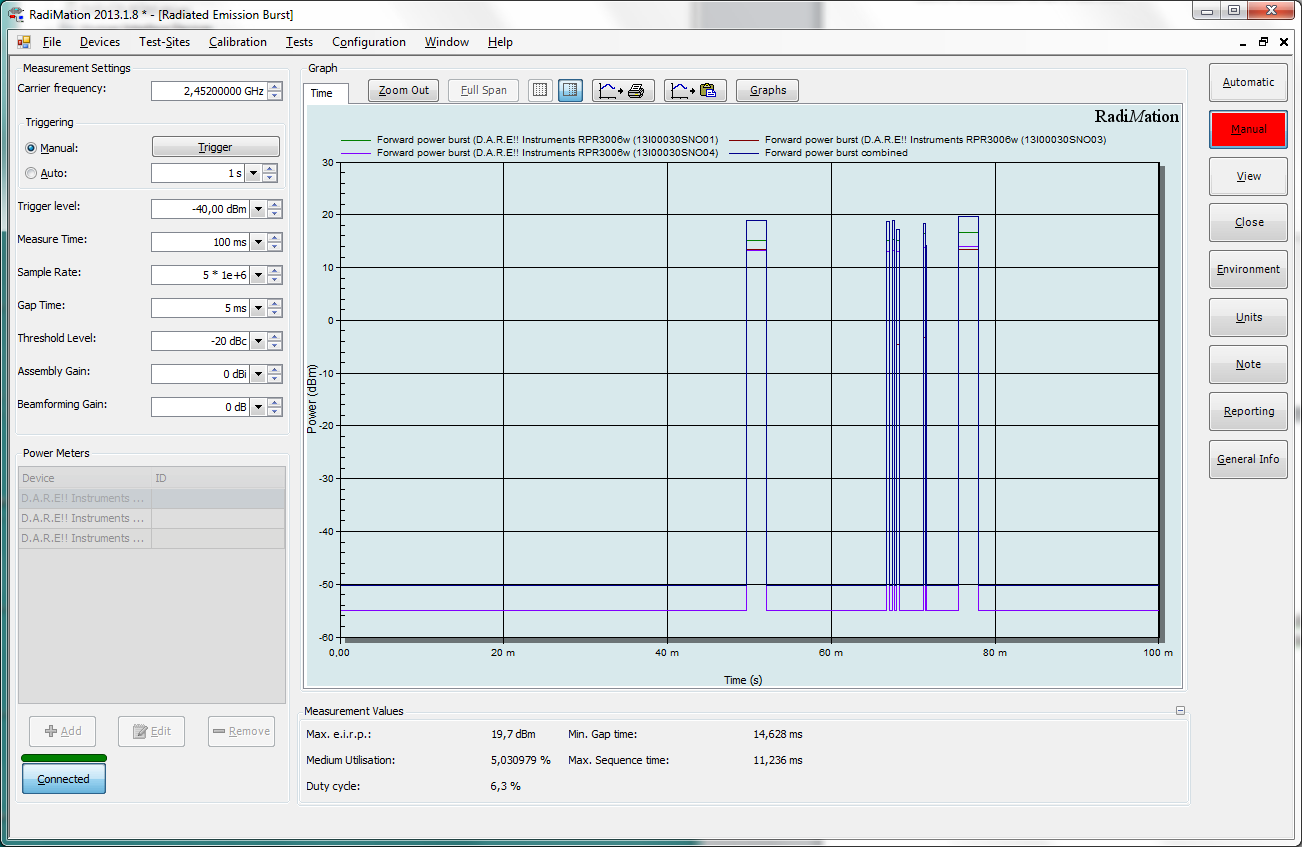Difference between revisions of "Radiated Emission Burst Status"
| Line 1: | Line 1: | ||
[[File:RadiatedEmissionBurstResult.png]] | [[File:RadiatedEmissionBurstResult.png]] | ||
| − | This window shows the result of a [[Radiated Emission]] Burst measurement, as it is described in the [[ETSI | + | This window shows the result of a [[Radiated Emission]] Burst measurement, as it is described in the [[ETSI EN 300 328]] standard. |
Also see the {{WindowTitle|Radiated Emission Burst TSF}} window on how tho configure the burst test. | Also see the {{WindowTitle|Radiated Emission Burst TSF}} window on how tho configure the burst test. | ||
| Line 9: | Line 9: | ||
{{ScreenElementDescriptionStart}} | {{ScreenElementDescriptionStart}} | ||
{{ScreenElementDescription|Graph|Shows the measurement result of the burst measurement. The individual measurement of each selected powermeter will be shown, and also the combined measurement result of all the graphs. It is possible to zoom-in on the measurement data to have more measurement details.}} | {{ScreenElementDescription|Graph|Shows the measurement result of the burst measurement. The individual measurement of each selected powermeter will be shown, and also the combined measurement result of all the graphs. It is possible to zoom-in on the measurement data to have more measurement details.}} | ||
| − | {{ScreenElementDescription|Measurement Values|Shows some final resulting measurement values as it is required by the [[ETSI | + | {{ScreenElementDescription|Measurement Values|Shows some final resulting measurement values as it is required by the [[ETSI EN 300 328]]}} |
{{ScreenElementDescription|Max. e.i.r.p.|Shows the maximum effective isotropic radiated power of the last combined measurement data.}} | {{ScreenElementDescription|Max. e.i.r.p.|Shows the maximum effective isotropic radiated power of the last combined measurement data.}} | ||
{{ScreenElementDescription|Medium Utilisation|Shows the percentage of the medium utilisation of the last combined measurement data.}} | {{ScreenElementDescription|Medium Utilisation|Shows the percentage of the medium utilisation of the last combined measurement data.}} | ||
Latest revision as of 19:43, 31 January 2024
This window shows the result of a Radiated Emission Burst measurement, as it is described in the ETSI EN 300 328 standard. Also see the Radiated Emission Burst TSF window on how tho configure the burst test.
During the measurement, the resulting measurement values such as Max. e.i.r.p, medium utilisation, Duty cycle, Min. Gap time,Max. Sequence time and RMS are calculated and shown.
The following values are available:
| Shows some final resulting measurement values as it is required by the ETSI EN 300 328 |
| Shows the maximum effective isotropic radiated power of the last combined measurement data. |
| Shows the percentage of the medium utilisation of the last combined measurement data. |
| Shows the percentage of the time that a transmission was active during the last combined measurement data. This is the total TxSequence time compared to the total TxGap time. |
| Shows the smallest period of time that was designated as a gap during the last combined measurement data. |
| Shows the largest period of time that was designated as a transmission during the last combined measurement data. |
| Shows the total RMS power of the complete last combined measurement data (including the gap and transmissions). This value should be the same as the power meter reading of True RMS powermeter. |
| Contains more measurement parameters that can be changed. |
| The primary frequency that will be measured by the powermeters. This frequency is used to correct the measurement result of the powermeters. |
| Selects the manual triggering mode, where a new measurement is only performed when the Trigger button is pressed. |
| The total time for the measurement |
| The sample rate that should be used by the powermeters |
| The Gap Time specifies the minimum time that the measurement samples should be below the Trigger level to designate that period of time as a gap in the transmission |
| The gain of the antenna that is normally connected to an output of the EUT. This Assembly Gain is used to calculate the total e.i.r.p. power. |
| The gain of the additional benefit of the combining of the multiple antenna's of the EUT. This Beamforming Factor is used to calculate the total e.i.r.p. power. |
| Shows the list of currently selected powermeters that will be used during the measurement |
| Allows to add one or more power meters to your test. |
| Shows the device driver configuration of the selected powermeter |
| Removes the selected powermeter from the list of powermeters that will be used |
| Shows the connection state with the selected powermeters. Also the connection with the powermeters can be disabled or re-activated by pressing the Connected button. |
